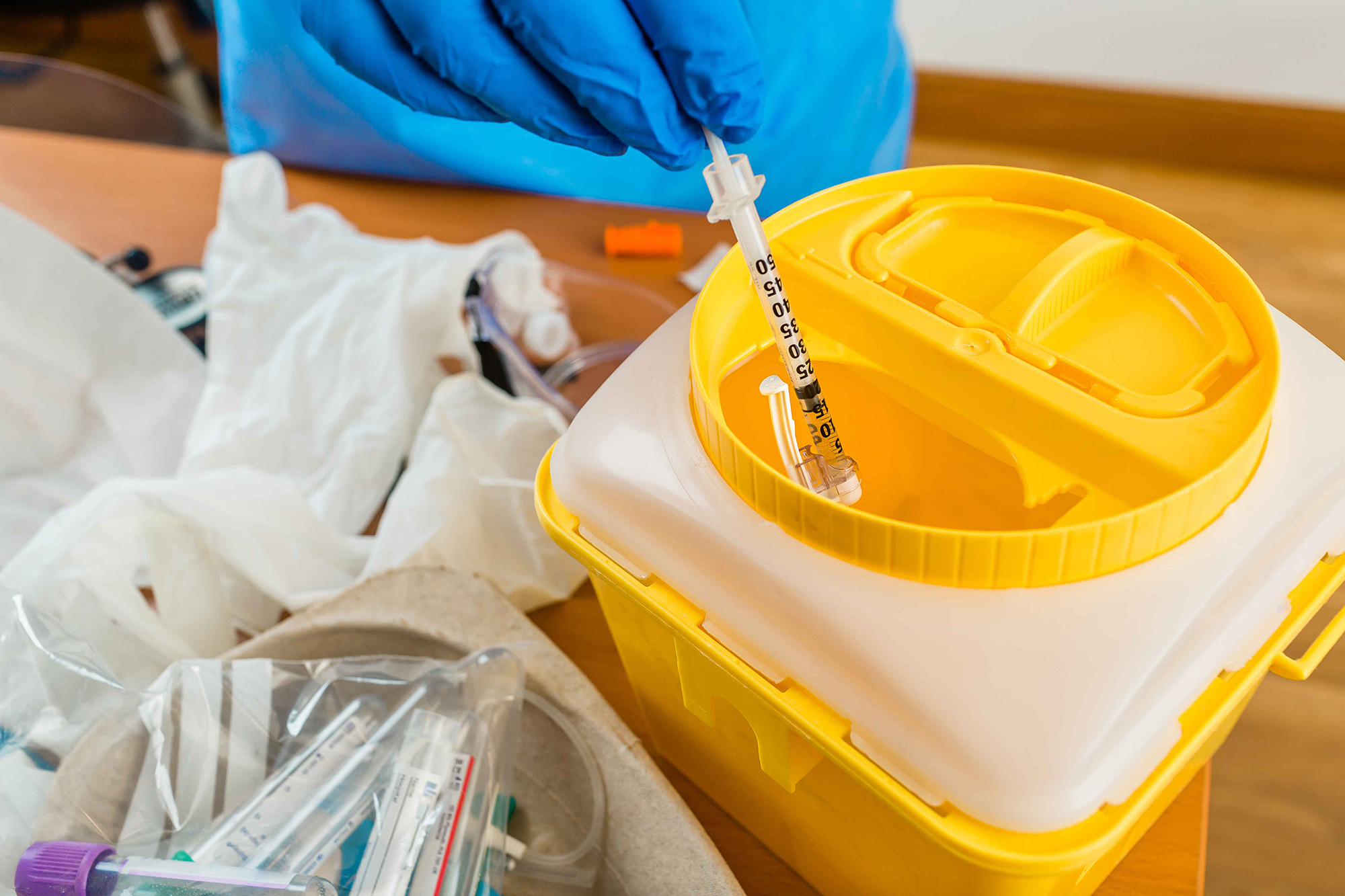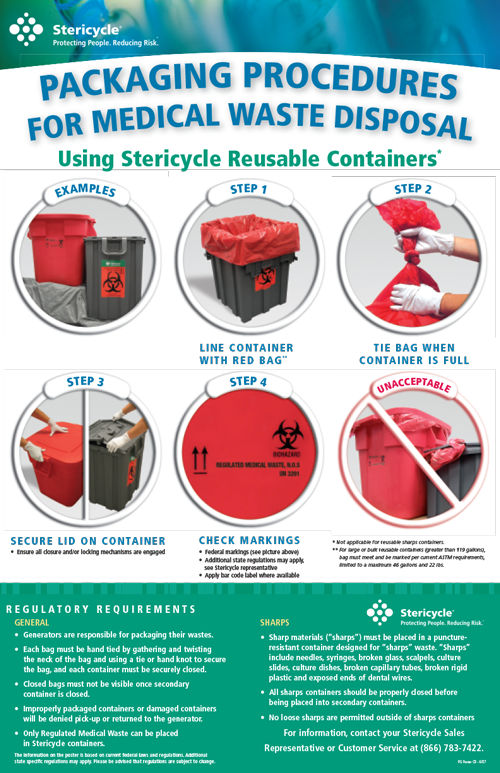Sustainable Solutions for Medical Waste Disposal
The proper administration and disposal of medical waste is crucial in maintaining a lasting and risk-free healthcare system. As the quantity of clinical waste proceeds to increase, discovering sustainable solutions comes to be increasingly vital. This necessitates the adoption of eco pleasant and efficient methods for disposing of clinical waste. This introduction will certainly check out various lasting remedies for clinical waste disposal, consisting of waste segregation and sorting, on-site waste therapy systems, recycling and reuse programs, waste-to-energy conversion innovations, as well as cooperation and education initiatives. By carrying out these services, medical care centers can not only decrease the environmental influence of medical waste, yet also make certain the security of health care employees and the public.
Waste Partition and Sorting
The process of waste partition and sorting is essential in making certain proper administration and disposal of clinical waste. Medical waste is classified into various categories based on its prospective threat to human wellness and the environment. Appropriate partition and sorting of waste aid to reduce the danger of contamination and make certain that each type of waste is taken care of and thrown away suitably.
The primary step in waste segregation and sorting is to identify and separate various sorts of clinical waste at the factor of generation. This includes recognizing the different categories of waste, such as transmittable waste, sharps waste, pharmaceutical waste, and chemical waste. medical waste disposal. Each classification needs specific managing and disposal techniques to stop injury to medical care employees, people, and the setting

On-site Waste Therapy Systems
Proceeding from the previous subtopic on waste partition and sorting, an effective solution for lasting medical waste disposal is the execution of on-site waste treatment systems - medical waste removal service. These systems allow health care centers to treat their medical waste on-site, reducing the demand for transport and disposal at off-site centers. On-site waste treatment systems typically consist of technologies such as autoclaves, microwave systems, or chemical disinfection devices
Autoclaves, frequently used in medical care settings, make use of high-pressure steam to decontaminate and treat medical waste. This procedure successfully eliminates germs, viruses, and other possibly damaging microorganisms, making the waste safe for additional handling and disposal. Microwave systems, on the various other hand, usage microwave radiation to warmth and treat the waste, attaining similar results to autoclaves.
Chemical disinfection systems entail using chemicals to decontaminate and treat clinical waste. These devices can make use of different anti-bacterials, such as chlorine-based services, to counteract pathogens and minimize the threat of contamination. The treated waste can after that be securely taken care of in regular waste streams or go through more treatment, such as shredding or incineration.
Executing on-site waste therapy systems provides a number of benefits. It reduces the environmental effect connected with transporting medical waste to off-site centers, minimizing carbon emissions and the danger of mishaps throughout transportation. In addition, it supplies medical care centers with more control over the treatment process, making certain conformity with laws and reducing the potential for unauthorized access to sensitive medical waste.
Recycling and Reuse Programs
To even more improve lasting clinical waste disposal methods, health care centers can implement recycling and reuse programs, developing upon the structure of on-site waste therapy systems. Recycling and reuse programs offer an added layer of environmental obligation by drawing away clinical waste from garbage dump and finding different uses for specific materials.
One secret element of reusing and reuse programs is the segregation of waste at the source. medical waste disposal. By carrying out correct waste partition methods, medical care centers can divide recyclable products, such as plastics, steels, and glass, from non-recyclable waste. This permits for the reliable recycling of these products, minimizing the demand for virgin resources and minimizing the environmental impact of medical garbage disposal
In enhancement to reusing, health care centers can discover possibilities for recycling specific medical items. As an example, single-use things like surgical drapes and dress can be sterilized and reused, lowering the demand for brand-new materials and minimizing waste generation. Multiple-use sharps containers can also be used, minimizing the amount of plastic waste created from non reusable containers.
Carrying out recycling and reuse programs requires correct framework and training - WasteX Medical Waste Disposal. Healthcare centers should buy proper recycling containers, segregation systems, and sanitation devices, along with guarantee team are informed on correct waste administration techniques
Waste-to-Energy Conversion Technologies
One potential technique to resolve clinical garbage disposal sustainably is through the application of waste-to-energy conversion innovations. These technologies use a promising remedy to the growing issue of clinical waste, which postures considerable ecological and public health dangers. Waste-to-energy conversion entails converting the organic parts of medical waste right into energy, such as heat or power, through various processes like pyrolysis, incineration, and gasification.
Incineration is one of the most typically utilized waste-to-energy technology for clinical waste disposal - WasteX Medical Waste Disposal. It involves the controlled burning of waste at high temperature levels, converting it into ash, gases, and heat. This heat can be used to create heavy steam, which can after that be converted right into electricity
Pyrolysis and gasification are newer innovations that supply more eco-friendly alternatives to incineration. Pyrolysis involves heating the waste in the absence of straight from the source oxygen, causing the manufacturing of gases and char. Gasification, on the various other hand, transforms waste right into a synthetic gas or "syngas" that can be used as a fuel for electricity generation or various other commercial procedures.
These waste-to-energy conversion technologies not only lower the quantity of medical waste but additionally give a resource of renewable resource. In addition, they can aid minimize greenhouse gas discharges and reliance on nonrenewable fuel sources (WasteX Medical Waste Disposal). It is important to make sure that these technologies are applied with correct exhausts control procedures to reduce any type of potential negative influences on air top quality and public wellness.
Partnership and Education Efforts
Cooperation among stakeholders in the health care sector is essential for implementing lasting services for clinical garbage disposal. In order to efficiently resolve the challenges connected with clinical waste management, it is necessary for healthcare facilities, waste monitoring business, regulatory authorities, and other pertinent parties to interact.

Additionally, education initiatives play an essential duty in advertising lasting methods. Health care professionals require to be mindful of the ecological impact of improper waste monitoring and the relevance of carrying out sustainable services. Training programs and instructional products can help them recognize the appropriate segregation of waste, using environmentally friendly alternatives, and the advantages of waste-to-energy conversion innovations.
Collaboration and education and learning can likewise promote the advancement of policies and standards for medical waste disposal. By interacting, stakeholders can add to the development of extensive policies that ensure risk-free handling, transportation, and therapy of medical waste.
Verdict
To conclude, adopting lasting solutions for clinical waste disposal is vital in order to lessen the negative effect on the environment and public wellness. Waste segregation and sorting, on-site waste therapy systems, recycling and reuse programs, waste-to-energy conversion technologies, and cooperation and education efforts are all important approaches to achieve this objective. Implementing these remedies needs cooperation between health care centers, waste management business, and federal government agencies, in addition to continuous education and learning and recognition campaigns.
The process of waste partition and sorting is crucial in making sure proper management and disposal of medical waste.The initial action in waste segregation and sorting is to determine and divide various kinds of clinical waste at the factor of generation. This entails recognizing the numerous categories of waste, such as infectious waste, sharps waste, pharmaceutical waste, and chemical waste.Continuing from the previous subtopic on waste partition and sorting, a reliable solution for sustainable medical waste disposal is the execution of on-site waste treatment systems. The cured waste can then be securely disposed of in normal waste streams or go through further treatment, such as shredding or incineration.